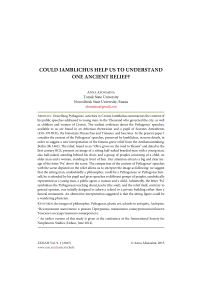Could Iamblichus help us to understand one ancient relief?
Автор: Afonasina Anna
Журнал: Schole. Философское антиковедение и классическая традиция @classics-nsu-schole
Рубрика: Визуальный образ античного философа
Статья в выпуске: 1 т.9, 2015 года.
Бесплатный доступ
Describing Pythagoras’ activities in Croton Iamblichus summarizes the content of his public speeches addressed to young men, to the Thousand who governed the city, as well as children and women of Croton. The earliest evidences about the Pythagoras’ speeches, available to us are found in an Athenian rhetorician and a pupil of Socrates Antisthenes (450-370 BCE), the historians Dicearchus and Timaeus, and Isocrates. In the present paper I consider the content of the Pythagoras’ speeches, preserved by Iamblichus, in more details, in order to suggest a new interpretation of the famous grave relief from the Antikensammlung, Berlin (Sk 1462). The relief, found in an “Olive grove on the road to Eleusis” and dated to the first century BCE, presents an image of a sitting half-naked bearded man with a young man, also half-naked, standing behind his chair, and a group of peoples consisting of a child, an older man and a woman, standing in front of him. Our attention attracts a big and clear image of the letter ‘Psi’ above the scene. The comparison of the content of Pythagoras’ speeches with the scene depicted on the relief allows us to interpret the image as following: we suggest that the sitting man, undoubtedly a philosopher, could be a Pythagorean or Pythagoras himself; he is attended by his pupil and gives speeches to different groups of peoples, symbolically represented as a young man, a public agent, a woman and a child. Admittedly, the letter ‘Psi’ symbolizes the Pythagorean teaching about psyche (the soul), and the relief itself, contrary to general opinion, was initially designed to adorn a school or a private building rather than a funeral monument. An alternative interpretation suggested is that the sitting figure could be a wandering physician.
The images of philosopher, pythagoras, plastic art, schools in antiquity, asclepius
Короткий адрес: https://sciup.org/147103404
IDR: 147103404
Текст научной статьи Could Iamblichus help us to understand one ancient relief?
ΣΧΟΛΗ Vol. 9. 1 (2015)
-
I. A Grave (?) Relief of a House Philosopher?
The historian of ancient philosophy cannot miss a fine ancient relief kept in Berlin, which was, according to the museum plate, found in an “Olive grove on the road to Eleusis”. This olive grove is located near the Dipylon Gate and the Plato’s Academy, one of the most notable places of the deme Colonus, the birthplace of Sophocles (according to his Vita , 1), and the scene of his Oedipus at Colonus .
One immediately notes that its attribution as a “grave” relief is at least questionable. I think the relief would better fit a public or private building of some sort, such as a school, a religious institution, or a theatre/bouleuterion.
Let us look at the picture. The museum plate reads:
“Four men of various ages and a girl stand or sit before a flat background. The seated figure, emphasized by his size, is interpreted as being the house philosopher of the family. The sign in the window-like section at the upper edge is reminiscent of the letter Ψ (Psi) and perhaps alludes to the psyche.”
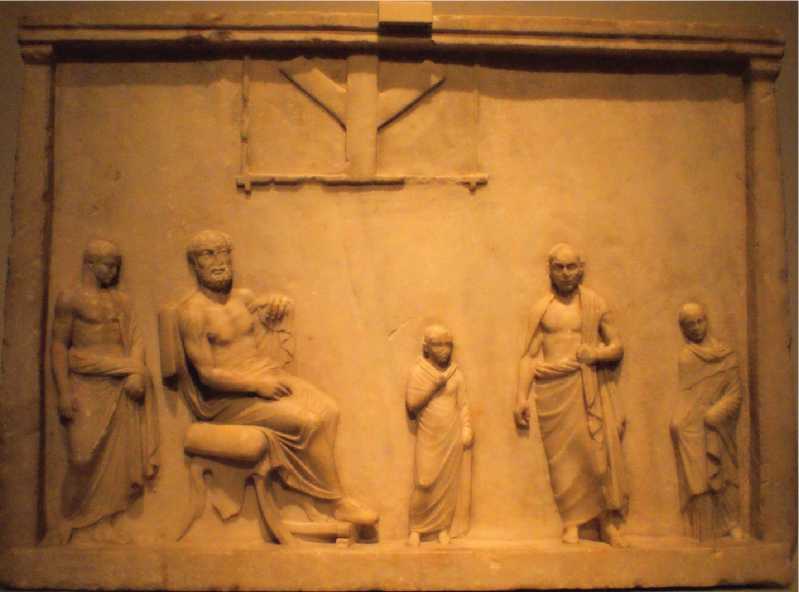
A grave (?) relief of a ‘house philosopher’(?). Athens, marble, 1st century BCE. The Antikensammlung, Berlin (Sk 1462). Photographed by the author
P. Zanker (1996, 187–188) is more specific. Comparing sculptural and relief representations of intellectuals from different periods he aims to show the evolution of their appearance in the Greco-Roman world and emphasizes the role of philosopher in late Hellenistic period as an interpreter of the classical tradition as well as an advisor and a tutor:
“Underneath the large framed picture (or window?) bearing the enigmatic sign [T], a philosopher is seated with his family. His portrait, like that of Poseidonius, is patterned after Late Classical models. Although he has no other heroic traits and sits comfortably in a chair, he is shown on a much larger scale than all the other, standing figures. This is presumably [my emphasis. - A.A.] a grave monument1 that a father commissioned for the resident philosopher to whom he had entrusted the education of his three children. The difference in scale is supposed to convey the great awe in which the teacher is held, and the success of his teaching is expressed in the well-bred manners and poses of the children, a young man, a youth, and a girl. The father is characterized by his bald head and realistically rendered face as an unmistakable individual and wears the same outfit as the philosopher and elder son, a hi-mation without a garment beneath it. This is not the current fashion and marks him as an adherent of the philosophical way of life. If we interpret the curious symbol above the philosopher as a psi (T), it could be a reference to the concern for the peace and security of the soul common to all those depicted here. The intimate ambience of the scene brings to mind the Greek philosophers employed in the households of contemporary Roman aristocrats. But there, no matter how much the Romans valued the company of the philosopher and relied on his advice in times of spiritual crisis, they would not have accorded him such a position of honor within the family. The relief is thus a particularly impressive testimony to the high status accorded philosophical teaching in the Late Hellenistic world”.
-
II. Inside or outside?
This interpretation clearly requires some qualifications. First, let us examine the sitting figure more attentively. The man alone is depicted in very distinct shoes, called calcei , enclosed footwear worn by the civilians of all levels everywhere in the Roman world. It is well known that indoors the Roman citizens normally wore sandals with a tunic and a stola, while the sandals did not fit well for wearing outdoors with a toga and a palla.2
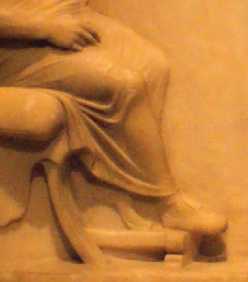
Obviously the sculptor wanted to emphasize the fact that the bearded man has just came from somewhere and spent some time on his way before meeting with the family. I would also suggest that the meeting has occurred outside and, quite probably, the man arrived upon the pater familias’ request. This type of footwear was a privilege of the civilians, which may indicate that the person is a wondering Italian sage (from the Italian Cro
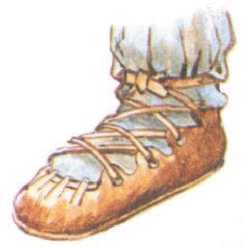
ton?), who uses to visit different cities and well-to-do houses looking everywhere for talented young men and the parents who are ready to support them. This reminds us a Pythagorean or a sophist, rather than a “house philosopher”. It is quite imaginable that he is a medicus , since the physicians also traveled long ways
and styled themselves as philosophers.
-
III. A Pythagorean scene?
In front of the sage we can see three figures: an adult man, a girl and a boy. The adult man is beardless, bald or has a short cut. The wrinkles on his forehead indicate his age. He wears a himation, while his face resembles the portraits of roman citizens. The girl and the boy are completely wrapped in their closes; their faces are depicted less accurately.
The choice of the characters on the relief is reminiscent of the listeners of the famous Pythagorean speeches, detailed content of which we find in Iamblichus’ “On the Pythagorean way of life”. Describing Pythagoras’ activities in Croton Iamblichus summarizes the content of his public speeches addressed to the young men, to the Thousand who governed the city, to the children of Croton and to the women. The earliest evidence about the Pythagoras’ speeches, available to us is an Athenian rhetorician and a pupil of Socrates Antisthenes (450–370 BCE). He says nothing about their content. However when he explains the Homeric epithet πολύτροπος he compares the skillfulness of Odyssey with the talent of Pythagoras to give speeches addressed to the different social and age-related groups: he spoke with the children in the manner proper to their age, to the women in relation to the matter which con-
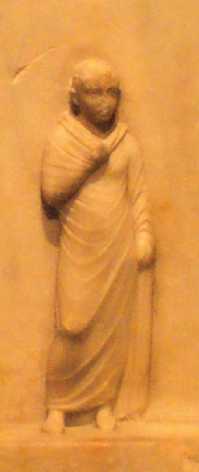
cern them, to the politicians – concerning the public affairs, and to the young men, accordingly, – in the way most suitable to the listeners (ἐπιστάμενοι δὲ πολλοὺς τρόπους λόγων περὶ τοῦ αὐτοῦ πολύτροποι ἂν εἶεν. εἰ δὲ οἱ σοφοὶ καὶ <ἀνθρώποις συνεῖναι> ἀγαθοί εἰσι, διὰ τοῦτό φησι τὸν Ὀδυσσέα Ὅμηρος σοφὸν ὄντα πολύτροπον εἶναι, ὅτι δὴ τοῖς ἀνθρώποις ἠπίστατο πολλοῖς τρόποις συνεῖναι. οὕτω καὶ Πυθαγόρας λέγεται πρὸς παῖδας ἀξιωθεὶς ποιήσασθαι λόγους διαθεῖναι πρὸς αὐτοὺς λόγους παιδικούς, καὶ πρὸς γυναῖκας γυναιξὶν ἁρμοδίους, καὶ πρὸς ἄρχοντας ἀρχοντικούς, καὶ πρὸς ἐφήβους ἐφηβικούς·, fr. 51 Caizzi; Porphyry, Schol. ad. Od. 1.1). Approximately in the same period Isocrates in his Busiris 29 tells us about Pythagoras’ fame: “For so greatly did he surpass all others in reputation that all the younger men desired to be his pupils, and their elders were more pleased to see their sons staying in his company than attending to their private affairs” (Norlin’s translation). Plato in the Republic 600a-b notes that Pythagoras “was the leader in upbringing” (ἡγεμῶν παιδείας), who established a special Pythagorean way of life. Mentioning the speeches in his biographical work Di-cearchus says nothing about their content but, in his manner, empha sizes the Pythagorean secrecy (fr. 33 Wehrli=Porphyry, Life of Pythagoras, 18). A slightly more detailed evidence about Pythagoras’ speeches is found in another Hellenistic historian Timaeus (ap. Iust. XX, 4, 1–13). According to him Pythagoras convinced the women to forget about their expensive clothes and jewelry, and keep the modest way of life. All this allows us to accept the historicity of the event, although the details of Iamblichus’ account is undoubtedly his literary creation.
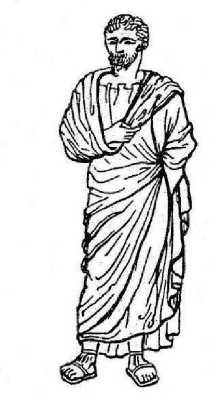
Having found, according to Iamblichus, the young men the most receptive of philosophical ideas he directed his first speech to them ( On the Pythagorean way of life , 37 ff., Dillon–Hershbell’s transl.). Could the young man depicted behind the sitting sage be interpreted in this context as a new Pythagorean convert?
The man in a himation staying in front of the sage represents the next group of the Pythagorean listeners – the Thousand who governed the city. Depicting a respectable citizen, on the “philosophical manner”, in a himation without a garment beneath it, the sculptor probably wanted to convey the idea that the governors heeded Pythagoras’ advices and accepted not only the philosophical way of thought, but also a quite distinct way of life. Iamblichus tells about this the following: “Upon hearing this, they built a temple to the Muses and dismissed the concubines whom they were accustomed to keep” (50).
Next two groups of the listeners, children and women, are symbolized by two smaller figures – a boy completely wrapped in outwear and a girl staying covered. «By praising their piety,” – reports Iamblichus, – Pythagoras “brought about such a great change towards thrift in regard to apparel, that no one dared to wear expensive clothes, but all placed countless articles of clothing in the temple of Hera» (56).3 Thus the girl wrapped in palla4 with her head covered can be read as a symbol of modesty and good conduct among women.
-
IV. An enigmatic sign
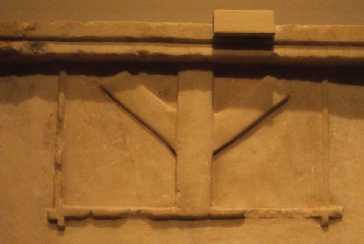
If we accept that this sign is “Ψ” then what it could mean? Can it symbolize the soul (psykhe), the Pythagorean idea of meten-somatosis, or, say, an idea of choice? Compare Isidore of Seville who writes in his Etymologies: “Pythagoras of Samos first formed the letter Y as a symbol of human life. Its lower stem signifies the first stage of life, an uncertain age indeed, which has not yet given itself to vices or to virtues. The branching into two, which is above, begins with adolescence: the right part of it is arduous, but leads toward a blessed life; the left is easier, but leads to death and destruction” (Orig. 1, 3, 7–9, Barney–Lewis–
Beach’s transl.). Earlier in the middle of the first century CE a Roman poet and satirist Persius spoke about it thus:

And where the letter has spread out into Samian
Branches it has shown you the way that rises by means of The right-hand path.
( Satires 3.56, quoted by Isidore)
Isidorus illustrates an idea of the choice with the help of the letter “Y”, accepted by him as a sign of human life. Both Persius and Isidorus clearly indicate the closeness of the letter “Y” to the Pythagorean tradition.
Letters “Y” and “Ψ” resemble each other, thus the idea of a branching and this of choosing the way of life could also be discerned in the image of “Ψ” by a symbolically-oriented mind. One also cannot exclude a possibility that this is just a part of a house construction.
V. Some conclusions
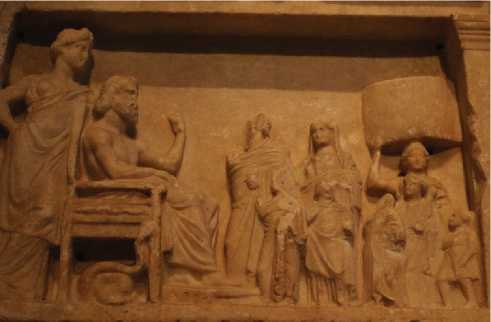
-
1. Having examined some ancient sources and modern studies we can provisionally conclude that the relief of the first century BCE reflects the idea of Pythagoras’ moral speeches, directed to different groups of Crotonian people. Where the meeting occurred? Inside or outside? We suggest that outside the house. The central figure, the
-
2. There are no direct indications that the relief was a part of a funeral installa-
- tion. Since it was found in Colonus near the Academy and on the way to Eleusis I find it probable that the relief served as a home or school adornment and its content
-
3. And, last but not least, one can note a typological resemblance between the figures of Asclepius (as, for instance, the one from the An-tikensammlung, Berlin, and another one from the Asclepion at Corinth, both dated to the 4th cent.) and the sitting man from our relief. Asclepius is often depicted as a strong bearded man with curly hair sitting free and relaxed on the spiked throne. It would be too hasty to say that the man from our relief is Asclepius, or a representative of medical art, but it is suggestive that his position, haircut, carriage and overall social setting resemble each other. Thus the sitting man at our relief could well be interpreted as a family doctor and a young man behind the chair as his student.
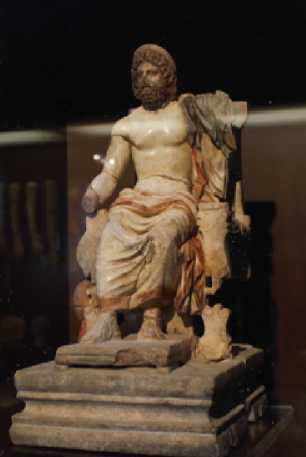
bearded man, has just arrived from a distant land, maybe from Italy, since this type of footwear is a privilege of the civilians. He is accompanied by his student and the family which invited him meet the guests at the doors. What is the purpose of the visit? Probably recruiting new students and giving talks.
had to remind of Pythagoras’ precepts.
Список литературы Could Iamblichus help us to understand one ancient relief?
- Barney, S. A., Lewis, I. W. J., Beach, J. A., tr. (2006) The Etymologies of Isidore of Seville. Oliver Berghof.
- Cleland, L., Davies, G. and Llewellyn-Jones, L. (2007) Greek and Roman dress from A to Z. Routledge.
- Dillon, J., Hershbell, J. (1991) Iamblichus, On the Pythagorean Way of Life. Atlanta, Georgia.
- Norlin, G. (1980) Isocrates, in three volumes. Cambridge, MA, Harvard University Press.
- Rode, Ε. (1901) “Die Quellen des Jamblichus in seiner Biographie des Pythagoras,” Kleine Schriften. Bd. 2. Tübingen.
- Sebesta, J., Bonfante, L., ed. (1994) The World of Roman costume. University of Wisconsin Press.
- Smith, W., Wayte, W., Marindin, G. E. (1890) A Dictionary of Greek and Roman Antiquities. E-version in the Perseus database.
- Städele, А. (1980) Die Briefe des Pythagoras und der Pythagoreer. Meisenheim a.Glan.
- Zanker, P. (1996) The Mask of Socrates: The Image of the Intellectual in Antiquity. University of California Press.
- Zhmud, L. (2012) Pythagoras and the Early Pythagoreans. Oxford University Press.

